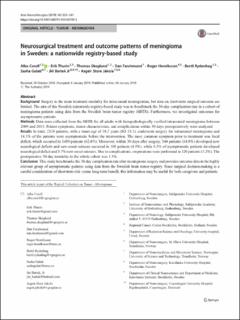| dc.description.abstract | Background
Surgery is the main treatment modality for intracranial meningiomas, but data on short-term surgical outcome are limited. The aim of this Swedish nationwide registry-based study was to benchmark the 30-day complication rate in a cohort of meningioma patients using data from the Swedish brain tumor registry (SBTR). Furthermore, we investigated outcomes for asymptomatic patients.
Methods
Data were collected from the SBTR for all adults with histopathologically verified intracranial meningioma between 2009 and 2015. Patient symptoms, tumor characteristics, and complications within 30 days postoperatively were analyzed.
Results
In total, 2324 patients, with a mean age of 58.7 years (SD 13.5), underwent surgery for intracranial meningioma and 14.1% of the patients were asymptomatic before the intervention. The most common symptom prior to treatment was focal deficit, which occurred in 1450 patients (62.4%). Moreover, within 30 days after surgery, 344 patients (14.8%) developed new neurological deficits and new-onset seizures occurred in 105 patients (4.5%), while 8.3% of asymptomatic patients developed neurological deficit and 3.7% new-onset seizures. Due to complications, reoperations were performed in 120 patients (5.2%). The postoperative 30-day mortality in the whole cohort was 1.5%.
Conclusion
This study benchmarks the 30-day complication rate after meningioma surgery and provides outcome data in the highly relevant group of asymptomatic patients using data from the Swedish brain tumor registry. Since surgical decision-making is a careful consideration of short-term risk versus long-term benefit, this information may be useful for both caregivers and patients. | en_US |

